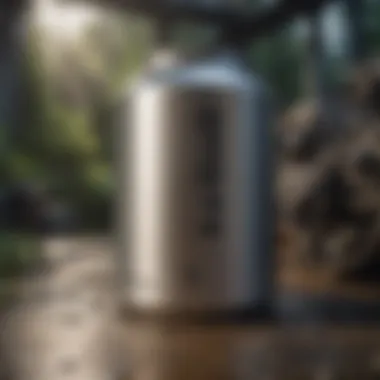Aluminum Paint from Sherwin Williams: Applications & Insights


Intro
Aluminum paint presents unique characteristics and benefits that are important for various applications. Sherwin Williams, as a leading paint manufacturer, offers high-quality aluminum paints that suit both industrial and domestic needs. The aim is to explore these paints comprehensively, looking at their composition, benefits, applications, and optimal use techniques.
Understanding aluminum paint is vital for anyone involved in projects requiring protective and decorative finishes. This article will elucidate the various aspects of aluminum paint, helping readers make informed decisions based on their specific requirements.
Composition of Aluminum Paint
Aluminum paint typically consists of a base of solvent mixed with aluminum flakes. This formulation provides several advantages. The aluminum particles assist in creating a reflective surface. In addition, the solvent ensures that the paint remains workable during the application process.
Key components include:
- Aluminum Metal Flakes: These give the paint its distinct finish and reflective qualities.
- Binder: This component helps in adhesion to surfaces, ensuring durability.
- Solvents: These make the paint fluid, allowing for easier application.
Understanding these elements is essential for choosing the right aluminum paint for any given project.
Applications of Aluminum Paint
Sherwin Williams aluminum paint is versatile, applicable in various situations. Its use extends from industrial applications to residential projects, thanks to its durability and aesthetic qualities.
Industrial Applications
- Protective Coatings: Many industries utilize aluminum paint to safeguard metal structures against corrosion. This makes it ideal for platforms and machinery exposed to harsh conditions.
- Heat Resistance: Aluminum paint can withstand high temperatures, making it suitable for equipment like boilers and exhaust systems.
Domestic Applications
- Aesthetic Renders: Homeowners often use aluminum paint for decorative purposes, enhancing features like fences, furniture, and even interior elements.
- Restoration Projects: It is also essential in restoring vintage pieces by providing a durable and attractive finish.
Advantages of Using Aluminum Paint
Numerous benefits make aluminum paint a favored choice, including:
- Corrosion Resistance: The reflective aluminum particles create a barrier against moisture, reducing rust and degradation.
- Durability: High-quality formulations ensure long-lasting performance.
- Aesthetic Appeal: The shiny, metallic finish enhances visual aspects of any surface.
- Cost-Effectiveness: Given its durability, aluminum paint can be more economical over time compared to alternatives that require frequent reapplication.
"Aluminum paint not only protects surfaces but also enhances their visual appeal, making it an ideal choice for diverse applications."
Considerations for Optimal Application
To achieve the best results with aluminum paint, it is essential to follow some application techniques:
- Surface Preparation: Ensure the surface is clean and free from dust, grease, or old paint.
- Priming: Use a suitable primer to improve adhesion.
- Application Method: Consider using spray guns for even application, especially on larger surfaces.
Tips for Selecting Aluminum Paint
When choosing aluminum paint from Sherwin Williams, consider the following:
- Intended Use: Evaluate whether the application is industrial or domestic, as this may influence your choice.
- Finish Required: Decide if a high-gloss or satin finish is more suited to your project.
- Environmental Conditions: Think about the exposure to elements, which influences paint performance.
Challenges and Maintenance Strategies
Challenges can arise during application, such as issues with adhesion or uneven coverage. Proper planning and application techniques help mitigate these challenges. In terms of maintenance, regular inspection and touch-ups as necessary will prolong the paint's effectiveness and appearance.
Preface to Aluminum Paint


Aluminum paint plays a crucial role in a variety of projects, both industrial and residential. As a specialized coating, it is designed to provide unique benefits that set it apart from traditional paints. Understanding aluminum paint's characteristics can significantly influence the selection process. This article examines its properties, applications, and how it enhances the durability and aesthetic value of surfaces.
Understanding Aluminum Paint Characteristics
Aluminum paint contains fine aluminum flakes, which lend a silver-gray appearance. This characteristic is not purely aesthetic; it also offers reflective properties. Such properties make it effective in heat management, especially on structures exposed to intense sunlight. The shine and reflective quality can reduce heat absorption, enhancing energy efficiency.
Moreover, aluminum paint is known for its strong adhesion. It bonds well to various substrates, ensuring longevity even in challenging environments. Another important feature is its ease of application. Unlike other complex coatings, aluminum paint often requires fewer specific conditions for successful application.
While evaluating aluminum paint, it is also vital to consider its drying time. Typically, it dries quickly, allowing for faster project completion. However, one must adhere to proper application techniques to avoid issues such as streaking or uneven finishes. Understanding these attributes helps users make informed decisions.
Chemical Composition of Sherwin Williams Aluminum Paint
Sherwin Williams provides aluminum paint that combines various materials, ensuring optimal performance. The primary ingredients include aluminum flakes, which serve as the pigment and provide the reflective characteristic. The paint is usually formulated with a resin that enhances durability and adhesion. This resin binds the aluminum flakes and ensures they maintain their properties under different conditions.
Also, solvents are employed in the mixture. They facilitate a smooth application, allowing for even spreading. The composition may also include additives designed to improve specific features such as drying time or resistance to mildew.
It's essential to recognize that the specific formulation may vary between products. Always refer to the manufacturer's technical data sheet for detailed information about the specific Sherwin Williams aluminum paint in use. Understanding the chemical composition is vital for assessing suitability for a particular application.
Applications of Aluminum Paint
Aluminum paint serves a crucial role across various sectors, combining functional benefits with aesthetic applications. Understanding these applications not only highlights its versatility but also emphasizes the importance of aluminum paint in contemporary projects. This section examines the different environments where aluminum paint thrives – industrial, residential, and specialty projects.
Industrial Applications
In the industrial sector, aluminum paint is widely utilized thanks to its superior durability and corrosion resistance. Many manufacturing and production facilities rely on it to protect structures and machinery from harsh elements.
- Structural Steel: Aluminum paint is often applied to structural steel components in factories and warehouses. This helps in safeguarding against rust, allowing for longer service life.
- Equipment Protection: Industrial equipment, which can be exposed to excessive moisture, benefits from aluminum paint. It creates a reflective barrier that reduces heat absorption, ultimately improving energy efficiency.
- Safety Marking: Use of aluminum paint for safety markings on floors and machinery is common. The reflective nature of aluminum improves visibility, enhancing workplace safety.
These applications prove the strategic value of aluminum paint for industries focusing on longevity and safety in their operations.
Residential Use Cases
In residential settings, aluminum paint finds diverse applications that marry appearance with protection. Homeowners often select it for its bright finish and functional attributes.
- Exterior Surfaces: Many people choose aluminum paint for exterior walls and fences. Not only does it provide a vibrant look, but it also protects wood and metal surfaces from the damaging effects of weather.
- Decorative Projects: Aluminum paint is also popular for various crafting projects around the house, such as upcycling old furniture. Its metallic sheen can transform everyday objects into appealing decor.
- Roof Coating: Using aluminum paint on roofs provides additional protection against UV rays while reflecting heat. This is especially useful in regions with high sunlight exposure, improving energy efficiency of homes.
These use cases reflect how aluminum paint enhances both the aesthetic and functional qualities of residential spaces.
Specialty Projects and Artistic Endeavors
Aluminum paint invites creativity in specialty projects and artistic endeavors. Artists and DIY enthusiasts utilize it to achieve unique visual effects and functional solutions.
- Art Installations: Artists employ aluminum paint to create striking sculptures or public artworks. The reflective quality can play with light, producing stunning visual experiences.
- Crafting: From adding a metallic touch to greeting cards to refurbishing antique items, aluminum paint enhances the creativity of artisans. Its application spans multiple mediums, including wood, metal, and glass.
- Sign Making: Crafting signs for businesses or events using aluminum paint is common. The clear visibility and shimmering appearance often attract more attention than traditional paint finishes.
The adaptability of aluminum paint in creative contexts illustrates its role as a facilitator for artistic expression and innovation.
Advantages of Using Aluminum Paint
Understanding the advantages of aluminum paint is critical for professionals and industry experts. This type of paint brings a number of benefits that make it highly suitable for various applications. Recognizing these advantages will help in making informed choices when considering the use of aluminum paint in different contexts.
Durability and Longevity
One of the most significant benefits of aluminum paint is its durability. This paint type can withstand harsh environmental conditions, including extreme temperatures and exposure to moisture. It adheres well to surfaces, which enhances its longevity. Furthermore, aluminum paint often includes compounds that prevent peeling and chipping, a common problem with other types of paints. This resilience translates into reduced maintenance costs over time. For long-term projects, opting for aluminum paint means fewer repaints and repairs, leading to more reliable outcomes in the long run.


Corrosion Resistance Properties
Aluminum paint is well-known for its impressive corrosion resistance properties. This quality is mainly due to the reflective nature of aluminum, which deflects ultraviolet rays and reduces the impact of environmental factors that can lead to corrosion. In industrial settings, where equipment and structures often face harsh chemicals and moisture, aluminum paint acts as an effective barrier. It protects metal surfaces from rust and degradation. This resistance not only extends the life of materials but also contributes to operational efficiency, thus aligning with sustainability goals in various industries.
Aesthetic Benefits
Apart from its functional advantages, aluminum paint offers considerable aesthetic benefits. This paint can provide a sleek, appealing finish that enhances the look of structures and machinery. The reflective qualities of the paint create a distinctive shine that can make surfaces stand out. This is particularly valuable in architectural applications, where visual impact can be as important as functionality. Additionally, aluminum paint can be mixed with colorants to achieve different shades, offering versatility to meet design intentions.
"Durability, resistance to corrosion, and aesthetic appeal make aluminum paint a valuable option for both industrial and residential applications."
Choosing aluminum paint ensures that projects not only function well over time but also maintain their visual appeal.
Application Techniques for Aluminum Paint
Application techniques for aluminum paint are crucial to achieving optimal results. Proper application influences both the performance and appearance of the paint. This section focuses on essential elements that contribute to effective usage.
Surface Preparation Steps
Surface preparation is critical for ensuring good adhesion and a smooth finish. The first step involves cleaning the surface thoroughly. This removes any dirt, grease, or previous paint that may impact the new coat's performance. Use a degreaser or a mild detergent solution to wash the area. After cleaning, make sure to rinse well and allow it to dry completely.
Next, inspect the surface for imperfections. Fill any holes or cracks with a suitable filler. Once the filler is dry, sand the area lightly to create a uniform surface. This prevents unevenness in the final coat. It is also advisable to test the surface by applying a small amount of the paint in an inconspicuous area. This ensures compatibility with the material.
Best Practices for Application
Using aluminum paint properly requires an understanding of application methods. Spraying is often recommended for a smooth finish, but brushing and rolling are also effective depending on the project's scale.
- Timing: Apply the paint in the right environmental conditions. Avoid excessive humidity and temperatures outside of the recommended range from the manufacturer.
- Consistency: Stir the paint thoroughly before use. This ensures consistent pigment distribution.
- Multiple Coats: Do not rush the application. Applying multiple thin coats typically yields better results than one thick coat. A timely first coat followed by a second after adequate drying can enhance durability and coverage.
- Direction: Always apply the paint in one consistent direction. This reduces the visibility of roller or brush strokes, thereby improving the final appearance.
- Drying Time: Allow for proper drying times as recommended in the product instructions before applying the next coat. This prevents lifting or wrinkling of the paint.
Tools and Equipment Recommendations
Selecting the right tools enhances the application process significantly. Below are recommended tools for working with aluminum paint:
- Spray Gun: Ideal for large surfaces, providing a smooth and even coat.
- High-Quality Brushes: Natural bristle brushes work well for detailed work and smaller areas.
- Rollers: Use rollers with a short nap for smooth surfaces. They help in even distribution.
- Drop Cloths: Protect surrounding areas to avoid mess and ensure clean lines.
- Masking Tape: Essential for achieving clean edges, especially if combining other colors or materials.
By throughly preparing the surface, using best practices for application, and employing the right tools, one can achieve effective outcomes with aluminum paint. This not only improves performance but also enhances the aesthetic appeal.
Challenges in Using Aluminum Paint
Understanding the challenges associated with aluminum paint is essential to fully appreciate its applications. While Sherwin Williams aluminum paint offers distinct advantages, recognizing potential issues allows for better project planning and management. With any product, there are nuances that may affect both the application process and the long-term performance of the paint. Addressing these challenges is paramount for ensuring successful outcomes in various settings, particularly industrial, commercial, and residential.
Common Application Issues
When applying aluminum paint, several application issues often arise. These problems can lead to unsatisfactory results if not addressed properly. For instance:
- Surface Preparation: Inadequate surface preparation is a frequent challenge. The surface must be clean, dry, and free of any contaminants. Neglecting this step can cause poor adhesion, leading to flaking or peeling.
- Temperature and Humidity: The environmental conditions during application play a crucial role. If temperatures are too high or humidity levels are elevated, the paint may not cure correctly. This could affect durability and overall performance.
- Application Technique: The method of application—whether spray, brush, or roller—can greatly impact the finish. Uneven application can create a patchy appearance. Using the wrong tool may also affect the thickness of the paint layer, leading to issues later.
Applying aluminum paint requires careful techniques. Often, beginners overlook the necessary steps, resulting in subpar finishes.
Addressing these common issues requires attention to detail and experience with the product. Ensuring that the application area is prepared correctly and observing environmental conditions can significant improve outcomes.
Environmental Considerations
Environmental factors are becoming increasingly important in paint selection and application. Aluminum paint is no exception. Here are key environmental considerations:


- Volatile Organic Compounds (VOCs): Aluminum paints often contain VOCs, which can contribute to air pollution. Checking for low-VOC or zero-VOC formulations is advisable for projects in enclosed spaces or areas with strict regulations.
- Waste Management: Proper disposal of leftover paint and cleaning materials is critical. Many regions have specific regulations about disposing of paints and solvents. Awareness of these rules can prevent legal consequences and environmental harm.
- Climate Impact: In locations with extreme weather, the choice of paint may need to consider how aluminum will react. Changes in temperature or moisture can affect the longevity and performance of aluminum finishes.
Considering these environmental factors is essential for professionals. Making informed decisions about product choices can lead to more sustainable practices while ensuring compliance with industry regulations.
Maintenance and Care for Aluminum Paint
Proper maintenance and care for aluminum paint is essential for preserving the appearance and integrity of any painted surface. When aluminum paint undergoes regular upkeep, it enhances its durability and longevity, ensuring that it retains its protective qualities. This section explores cleaning routines, inspection measures, and touch-up strategies to maintain the effectiveness of aluminum paint over time.
Cleaning and Upkeep
Cleaning aluminum paint surfaces is fundamental to keep them looking fresh and functional. Dirt, grime, and environmental pollutants can accumulate, affecting both appearance and performance. Here are key points regarding care routines:
- Routine Cleaning: Regularly wash painted surfaces with mild soap and water. Use a soft cloth or sponge to avoid scratching the paint finish.
- Avoid Harsh Chemicals: Stay away from abrasive cleansers or solvents. They can damage the surface and diminish the paint's protective features.
- Frequency of Cleaning: Aim to clean the surface at least every six months, or more frequently in dirty or polluted environments.
- Rinsing: After washing, always rinse with clean water to remove any soap residue.
Using these methods contributes to the longevity of the aluminum paint. Thorough cleaning helps to prevent the buildup of materials that might lead to corrosion or chipping over time.
Inspection and Touch-Up Techniques
Regular inspections of aluminum paint surfaces can prevent minor issues from becoming major problems. It is crucial to identify areas that may require touch-ups or repairs promptly. Effective inspection techniques include:
- Visual Inspections: Regularly inspect the surface visually to check for signs of peeling, fading, or rust. Pay close attention to edges and corners where wear is often more pronounced.
- Touch-Up Application: For any scratches or damages, apply Sherwin Williams aluminum paint for touch-ups. Ensure the area is clean and dry before application for better adhesion.
- Assessment of Surroundings: Check for environmental factors that may affect the paint, such as moisture or proximity to corrosive elements.
"Routine care and timely touch-ups can significantly extend the life of aluminum paint, ensuring surfaces maintain both function and aesthetic appeal."
Commercial and Professional Insights
Understanding the commercial and professional dimensions of aluminum paint is essential for informed decision-making in various applications. The aluminum paint provided by Sherwin Williams offers significant advantages, particularly in industries that prioritize durability, aesthetic enhancement, and corrosion resistance. Knowledge of these aspects can lead to better project outcomes, especially in commercial and industrial settings where long-term performance is critical.
Industry Standards and Regulations
In the realm of commercial applications, adherence to industry standards and regulations cannot be overstated. Various sectors require compliance with certain guidelines that dictate the appropriate use of materials, including paints and coatings. Sherwin Williams' aluminum paint is formulated to meet several critical standards.
- Environmental regulations: Many regions have strict guidelines regarding volatile organic compounds (VOCs) and emissions. Sherwin Williams has worked to ensure that its aluminum paints comply with such standards, making them suitable for both indoor and outdoor projects.
- Safety standards: For professional applications, safety certifications are crucial. Proper labeling, storage, and handling of aluminum paint are in line with Occupational Safety and Health Administration (OSHA) requirements to ensure safety in professional environments.
- Performance criteria: Many industries, including automotive and manufacturing, rely on paints that can endure harsh conditions. Sherwin Williams' aluminum paint offers properties such as resistance to chipping, peeling, and fading, meeting the performance standards these industries demand.
Professional Recommendations
For professionals in fields utilizing aluminum paint, several recommendations can enhance the efficacy of their work. Choosing the right product for each specific application, along with mastering the application techniques, ensures optimal results.
- Product Selection: Depending on the project requirements, professionals should consider factors such as gloss level, sheen, and finish. Sherwin Williams offers a variety of formulations tailored to specific applications, enabling professionals to select the most suitable option.
- Application Techniques: Utilizing the correct methods for application is vital. Spraying, brushing, or rolling are different techniques that may yield varied results based on the environment and desired finish. Professionals should follow Sherwin Williams' guidelines for achieving the best coverage and adhesion.
- Consultation and Support: Engaging with Sherwin Williams representatives can provide further insights into product selection and application. Their expertise can help professionals refine their approach and adopt new techniques or products aligned with industry standards.
"Choosing the right aluminum paint product and understanding its application can significantly affect project durability and appearance."
By investing time in understanding the commercial landscape of aluminum paint, professionals can enhance their projects' success. Knowing the standards, regulations, and practical recommendations allows for improved performance and results, solidifying aluminum paint's role as a valuable resource in various industries.
Finale and Future Directions
As we look towards the future, it is essential to consider the evolving landscape of aluminum paint technology. Ongoing research and innovations aim to enhance its formulation and performance, catering to the dynamic needs of users. Factors such as environmental impact and user safety will continue to shape the development of aluminum paint, prompting manufacturers to refine their products.
"Future advancements in paint technology must prioritize not just performance but also sustainability and health considerations in their formulations."
The incorporation of higher-quality raw materials and the focus on eco-friendly standards will likely lead to emerging trends. Professionals should remain attentive to these shifts, as adopting cutting-edge solutions may offer competitive advantages in the market.
Recap of Key Points
- Characteristics of Aluminum Paint: Aluminum paint is known for its reflective properties and ability to provide a protective barrier against various environmental factors.
- Applications: It finds extensive use in industrial settings, residential projects, and artistic works, making it a highly adaptable solution.
- Benefits: The durability, aesthetic appeal, and corrosion resistance provided by Sherwin Williams aluminum paint make it a desirable choice for many applications.
- Application Techniques: Proper surface preparation and application techniques ensure optimal performance and longevity of the paint.
- Challenges: Users face specific challenges such as maintaining surface integrity and managing environmental considerations during use.
- Maintenance: Regular inspection, cleaning, and touch-up techniques are vital in ensuring the paint remains effective over time.
Emerging Trends in Aluminum Paint Technology
As the demand for high-performance paints continues to rise, several key trends are shaping aluminum paint technology:
- Sustainability: Innovations are focused on producing environmentally friendly coatings with lower VOC emissions and sustainable sourcing of materials.
- Advanced Formulations: New formulations are being developed for enhanced durability and resistance, especially in challenging environments.
- Smart Coatings: Integration of smart technologies allows for paints that can change properties based on environmental conditions or user needs.
- Color Innovations: Enhanced color options and finishes are being explored, providing more aesthetic choices for users.
- User Safety: Improvements in the safety profile of aluminum paints, with fewer harmful chemicals being utilized in production, are increasingly essential.







